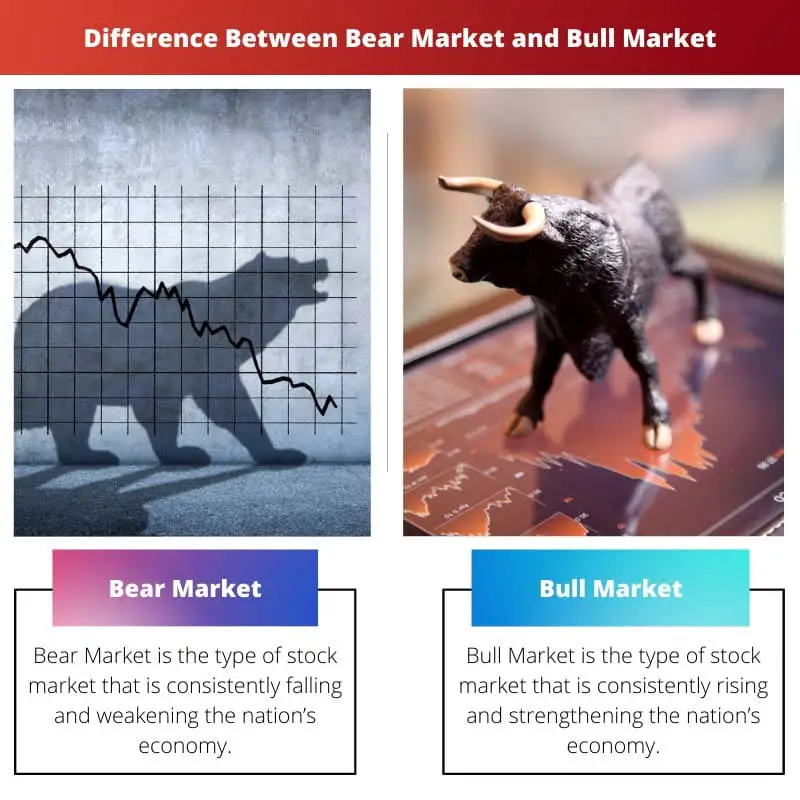The stock market is the trading of stocks representing ownership claims on various businesses worldwide. The stock market is classified into types, namely Bear Market and Bull Market, based on stock values, economy, GDP, etc. As the stock market takes a turn, the situation of the whole country changes.
Key Takeaways
- Bear markets exhibit declining stock prices, whereas bull markets showcase rising stock prices.
- Investor confidence wanes in bear markets while it flourishes in bull markets.
- Bear markets create opportunities to buy undervalued stocks, while bull markets offer chances to sell overvalued stocks for profit.
Bear Market vs Bull Market
The difference between a bear market and a bull market is that in a bear market, the stock prices are consistently falling, and traders look to sell their stocks, whereas in a bull market, the stock prices are consistently rising, and traders look to buy new stocks.

Bear Market is the type of stock market that is consistently falling and weakening the nation’s economy. In a bear market, the stock prices are on a decline, and with low GDP, insufficient disposable income, low liquidity, etc., Traders look to sell their stocks in bear markets.
Bull Market is the type of stock market that is consistently rising and strengthening the nation’s economy. In a bull market, the stock prices are on the rise, GDP growth, more disposable income, high liquidity, etc. Traders look to buy more stocks in bull markets.
Comparison Table
| Parameters of Comparison | Bear Market | Bull Market |
|---|---|---|
| Aim of Investors | The aim is to minimize the losses. | The aim is to make maximum profit. |
| Investor’s Approach | Pessimistic approach. | Optimistic approach. |
| Prices of Stocks | Stock prices fall. | Stock prices rise. |
| Economy | Economy weakens. | Economy strengthens. |
| Employment | High unemployment rate. | High employment rate. |
What is Bear Market?
Bear Market is the type of stock market in which the stock prices are consistently falling, and there is widespread investor pessimism. The market is said to have entered the bear phase when the stock prices dropped at least 20% from their recent high. The term Bear Market was derived from the animal Bear as it attacks in a downward direction, indicating the stock market’s fall.
The circumstances of the bear market include low stock prices, a low GDP rate, a weakening economy, and the crashing of large-scale businesses, etc. On top of that, the bear market results in a high unemployment rate. Hence, bear markets are not favourable for the nation.
There can be various causes for the rise of bear markets, such as changes in the tax rate, wars, political crises, etc. In bear markets, traders look to sell their stocks to minimize losses.
The Great Depression, which started in 1929 after the decline of stock prices, is the most evident example of a bear market. As long as the great depression lasted, the economy was globally on the decline. The unemployment rate had risen to its highest ever, and there was a worldwide financial crisis. In most nations, recovery from the great depression began after 1933.

What is Bull Market?
Bull Market is the type of stock market in which the stock prices are consistently rising, and there is widespread investor optimism and hope. The market is said to have entered the bull phase when the stock prices rose at least 20% from their recent low. The term Bull Market was derived from the animal Bull as it swings its head upward, indicating the stock market’s rise.
The circumstances of a bull market include high stock prices, a growing GDP rate, a strengthening economy, the establishment of large-scale businesses, etc. On top of that, the bull market results in a high employment rate. Hence, bull markets are favourable for the nation’s betterment.
There are various reasons for the rise of bull markets, such as the foundation of large firms, business cycle fluctuations, the establishment of new technology, etc. In bull markets, traders look to buy new stocks to maximize profits.
In the United States, a productive bull market began at the end of the stagflation era in 1982 and continued for the next 18 years. During this time, stocks of some companies rose to 5 times their original price. Furthermore, the country showed tremendous fundamental growth during this period.

Main Differences Between Bear Market and Bull Market
- The demand for stocks is low in the bear market, whereas the demand for stocks is high in bull markets.
- The aim of traders in bear markets is to minimize losses. On the other hand, in bull markets, traders aim to maximize profits.
- In a bear market, the economy and GDP of the national decline, whereas in a bull market, the economy and GDP of the nation consistently rise.
- Bear markets have high unemployment rates, whereas bull markets result in high employment rates.
- Traders are pessimistic in bear markets, whereas optimistic in bull markets.






